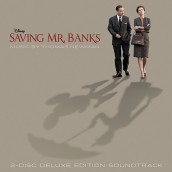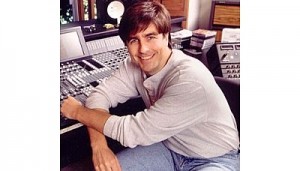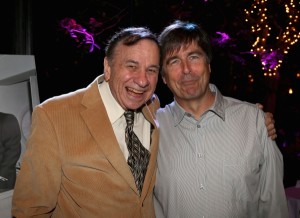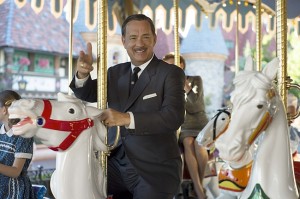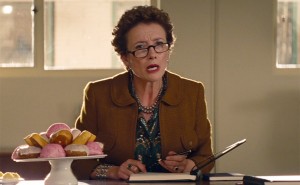Tuxedoed penguins, dancing chimney sweeps, a housekeeper floating in on an umbrella to tame a household of errant children – all accompanied by some of the most memorable songs to grace a Disney movie, let alone any family film in Hollywood via England history. These confections make for the enduring magic that is MARY POPPINS, a movie that’s melodiously synonymous with family warmth. However, the real story behind this heartwarming classic was anything but harmonious, especially when POPPINS decidedly Scrooge-like creator arrived in LA’s magic kingdom like a serving of castor oil – haunted by a childhood that was anything but a fairy tale. Such is the pre-production from hell fable that makes for the ultimate wonderment of SAVING MR. BANKS, not that the songwriting-scoring team of Richard and Robert Sherman ever thought they’d survive it.
Thankfully, Thomas Newman didn’t have to go through nearly a stormy experience to deliver one of his most magical scores for John Lee Hancock’s valentine to the Disney spirit. A solo composer who knows a thing about coming from a musically inclined family, Newman blazed a very different trail than father Alfred, brother David, or cousin Randy with his own brand of sumptuous orchestral sound and experimental, rock-based percussion and ethereal atmospheres. These boldly innovative styles have often worked in tandem, no more so than in his sumptuously groovy, Oscar-nominated score for “Finding Nemo,” which brought a whole new world of experimental groove to Disney animation.
Now given the classic tableaux of a groundbreaking movie that combined live action with animal-dancing toons, Newman creates a score that seamlessly blends the best of his musical worlds, as LITTLE WOMEN‘s proper English attitude crosses with the toe-tapping groove of two certain fish and the kitsch factor of 60s era Los Angeles, as given the beautiful melancholy of a deceptively blissful childhood. For even if you think MARY POPPINS itself is a near-diabetic experience, haters will come around as surely as P.L. Travers does to the Disney charm, especially with the score’s combination of sprightliness and nostalgia that plays the darkness which gave birth to the cinematic epitome of can-do happiness, all while saluting the Sherman Brothers. He’s indeed saved MR. BANKS with a beautifully thematic, and anachronistically wondrous score that’s the melodic starstuff that musical Hollywood happy endings are made of, even if the road to get MR. BANKS there is anything but a spoonful of sugar.
ASSIGNMENT X: SAVING MR. BANKS is essentially an adult film about a movie aimed towards young children. In that way, it’s really for the baby boomers that grew up on MARY POPPINS.
THOMAS NEWMAN: That’s right. It’s for the children we all used to be. I think that’s a very good point. I think all of us remember MARY POPPINS in our past and obviously we remember the songs to this day. It’s all caught up in our boomer memory.
AX: What did MARY POPPINS mean to you as a kid?
NEWMAN: The thing about MARY POPPINS that was so great was that I saw it at a time in my life for me when I was studying music, but probably not at all interested in it. So my response to the songs was purely just the joy of being a listener and a fan. It was back in the days when you would be singing “Supercalifragilisticexpialidocious,” “Chim Chim Cheree” and all these gorgeous tunes that Richard Sherman writes so well. I loved watching it.
AX: Did you study the music of MARY POPPINS before scoring SAVING MR. BANKS?
NEWMAN: I didn’t study it so much as listened to the original score again to delight in it. I didn’t want to do an “adaptation” score, and John assured me that wasn’t the idea. Most of my music takes place in the back story and spills into the 1961 story as you relate a young P.L. Travers to an older P.L. Travers.
AX: SAVING MR. BANKS is almost like a fairy tale within a fairy tale, as P.L. Travers deals with the ghosts of a deceptively golden childhood.
NEWMAN: I guess the film is steeped in the sense of how a child sees her father, and who the father really is. So it’s more of a character driven music score for me. When you do see Aunt Ellie come to the door, she’s kind of dressed like Mary Poppins, complete with a carpetbag, so it was kind of fun to play with the idea of a 3⁄4 time waltz piece for her that kind of harkens to a MARY POPPINS-type of musical place where that actually comes from the Richard Sherman songs.
AX: You’ve come up with a fun, imperious “army march” theme for the Australian P.L. that sounds very English in nature.
NEWMAN: I guess when you do anything like this that you try to take up the rhythms of the scenes, and apply music that seems to go with the character.
AX: What did you want to musically say about P.L. Travers?
NEWMAN: I don’t know if I wanted to “say” anything musically about her so much as I wanted to be in sync with where her flashback story was taking place, and how it related to her in 1961, when she’s portrayed as a difficult women. Her backstory kind of tells you that’s not exactly the case when P.L. was a little girl with a rich imagination that was marked the beginning of her story telling life. Now she’s a stranger in a strange land, who’s come from England not really wanting this movie to happen. She seems to not believe in anything that is American, in particular the whole Disney thing with the stuffed animals in her hotel room.
AX: Disney pretty much had a traditional orchestral approach to their animated movies before you applied your experimental, groove sound to FINDING NEMO, which the score to SAVING MR. BANKS hearkens to. Where you ever worried that this kind of “rock” rhythm would be anachronistic in a “period” movie?
NEWMAN: That’s because there was room for a real tune-based score here that could reflect the basic joy in that kind of writing that the Sherman Brothers brought to MARY POPPINS. Whenever I’ve done period pieces in the past, I’ve always tried to listen to a sound I was creating, and seeing if the imagery could work with those musical colors. You’re always testing your sense of music vocabulary against the scene to see if it holds, and if it will entice and immerse the audience. I need to know if the music is striking a psychological note as opposed to a moment of time and place. Then I watch and listen to what I’ve done, and decide if I buy it.
AX: My favorite is scene is when P.L. is singing “Let’s Go Fly A Kite” with the Shermans, and suddenly the orchestra picks up on the tune and carries it away into your own score.
NEWMAN: Although it’s really the Richard Sherman tune, I kind of wrote a bridge to it. I think everybody gets a kick when seeing these characters singing at the piano, because there’s nothing like a sing-a-long especially when it’s such a joyous tune like “Let’s Fly a Kite.” John Lee Hancock’s thought was to cut away from the rehearsal room to the secretary running down the hall to tell Walt Disney to come see what was happening. He really wanted the score to heighten that moment. I don’t think John really knew if it was a good or a bad idea, but we all loved it when we tried it. Putting an orchestra there really heightened that joyous breakthrough between P.L. and the Sherman Brothers.
AX: Conversely, how did you want to approach the bittersweet, and often-heartbreaking quality of this movie?
NEWMAN: I wanted the audience to be moved, but not necessarily drawn to pathos and tears by the music. By the time you get to these emotions, I wanted them to be earned it because they were there in the movie in the first place.
AX: Did you meet with Richard Sherman before starting on SAVING MR. BANKS?
NEWMAN: I think Richard gave me an award when I won an Annie for FINDING NEMO. I remember being amazed just to meet him. Richard was such an approachable guy. He came to the last orchestral recording date we had for our film at 20th Century Fox. He was unbelievably delightful, as sharp and nothing but supportive. Richard regaled all of us at lunch with stories about MARY POPPINS, P.L. Travers and Walt Disney. He was a total joy to be around.
AX: Did you identify with Richard and his brother in the scenes where they had to deal with P.L. Travers? And have you ever had to deal with your own version of such a seemingly impossible person?
NEWMAN: I think so. One of the big lessons that I took away is that even though so much of the music from MARY POPPINS is joyous, it began with despair, doubt and the sense that it would never happen. The emotional content that composers are writing has little to do with the actual emotions surrounding the creative process. I could really relate on that level, and to hear Richard’s stories about working with P.L. was just amazing.
AX: How have you gotten past your own “creative differences?” to finish a score that you might not have thought was doable?
NEWMAN: I think you have to be knowledgeable about human nature so there’s as little amount of blood spilled as possible. Sometimes luck will have it that it doesn’t work out, or it does, despite all. I’ve often wondered how you stay vulnerable and open emotionally, and musically, when the people around you can be unpleasant.
AX: When you look at the other side, what do you think about the importance of a director, or creator’s artistic integrity?
NEWMAN: I think it’s key. I’m a secondary creative force so you want to really honor the primary creative force if you really want to get good leadership out of your director. When it gets tough is when the leadership isn’t there, or the quality isn’t there. As a composer, you’re trying to please someone on the one hand, and also try to address the needs of the movie on the other. If those things are in conflict than the process can be really tough.
AX: Do you think sometimes the material’s creator can be completely and absolutely wrong about the right musical approach, making it your job to make the person realize you are right – and they are wrong?
NEWMAN: I think so, but what you have to do is solve something on their terms so they know you’re willing to do that. And if you want propose an alternative; you propose it next to something they think they want. It’s so much about human nature. I always have to remind myself that a director is on a project for 2-3 years. I come on for 12 weeks, so I really need to honor the director’s as much as I can despite what I may think of them.
AX: Walt Disney has a squeaky clean image. Was it fun for you going behind the scenes to show that everything about him all happy and cheerful all of the time?
NEWMAN: think John Lee Hancock really wanted it that way, and Tom Hanks did too. Everyone was nervous that this was a project about Disney made by Disney and what it would that mean in terms of the administration getting in this movie’s way just to protect their brand? In fairness to Disney they were very hands off, and were delighted to have this movie happen on it’s own terms, all the way down to the title – which you can argue is not at all Disneyesque. They believed in this movie enough to say that SAVING MR. BANKS is a good title, and meaningful to the content of the movie.
AX: What did you think that SAVING MR. BANKS has to say about the family dynamic of composers?
NEWMAN: As a kid, it was deeply intimidating. Randy was at the heyday of his songwriting strength when I was in school and college. Not to take anything away from his strength and prowess now, but man, there he was! Not only could he write beautifully, but he was the critics darling. My dad died when I was 14 so there was that hanging over me. When I started, I never thought I could pull it off on a level of “Geez, could I write this amount of music in this amount of time under these types of restrictions with the kind of powerful personalities that are in movie making?” It was the long shadow of The Newman’s. I think I was born as a composer when I finally gave up trying to be on anyone’s level, but my own.
AX: What do you think made the Sherman brothers work as a team?
NEWMAN: I think Richard said it was Richard’s father, who was a songwriter himself, said that he should team up with Robert. Richard said there was a great deal of fluidity in their creative relationship. He would describe music and songs as something that was soft clay that still had the ability to be changed. And the best way to work is was to constantly be open to change with input and collaboration. When you think about their songs, they are so memorable and elemental. As a kid, you really were hearing tunes you could sing and remember. Richard and Robert worked hard to achieve that.
AX:
NEWMAN: Happy endings are interesting when they are compelling and good. Musically, there’s something about conveying joy and there were several moments in SAVING MR. BANKS where I could evoke a sense of elation, and boy, that was a lot of fun. I wrote a lot of the music in three quarter time for that, and sometimes cues were in waltz time to really roll forward, as opposed to the 4/4 meter that tends to sit more. I think Richard would agree with that, as so many tunes in Mary Poppins are in 3⁄4 time.
AX: SAVING MR. BANKS is the second “Hollywood” movie you’ve done after THE PLAYER. And it’s a far more optimistic one by the end.
NEWMAN: What I enjoyed about THE PLAYER is that I started with a very eerie, odd melody. Then I got to do a kind of Alfred Newman treatment of it at the end. So there was a real ironic yin and a yang to that score. On the other end, it’s nice to hit a ball that’s right down the middle like SAVING MR. BANKS. It’s fun to musicalize that concept of joy being joy, which you hear the most in the end title because it was a chance to go back to a big scale melody in strings. At one point, I kind of conjured a one-man band as a small homage to Dick Van Dyke’s character of Burt at the beginning of MARY POPPINS. It’s a little four bar phrase at the end of the first part of my end title, where you got to honor the idea of what a beautiful film it was.
Buy Thomas Newman’s score for SAVING MR. BANKS HERE
AGREE? DISAGREE? LET YOUR VOICE BE HEARD – COMMENT BELOW
Follow us on Twitter at ASSIGNMENT X
Fan us on Facebook at ASSIGNMENT X
Article Source: Assignment X
Article: Interview with SAVING MR. BANKS composer Thomas Newman
Related Posts:




